 |
 |
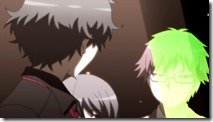 |
Welcome back, NoitaminA – it’s almost like you never left.
OP: “Speed to Masatsu (スピードと摩擦)” by amazarashi
 |
 |
 |
 |
 |
 |
No doubt, this season is front-loaded, so I’m not going to let this heady start make me giddy. But there’s no two ways about the fact that in Gangsta and Ranpo Kitan, Summer 2015 is off to a terrific start. Here’s another unconventional and challenging series, quite different from Gangsta but equally as far removed from the fashions of the day in anime. It’s also the first NoitaminA shows in quite some time that feels connected to what NoitaminA used to be all about – giving a vehicle to series that would otherwise struggle to find a place on the schedule.
The genesis of Ranpo Kitan is certainly an odd one, but I can’t help but be reminded of UN-GO when I consider it. The series is based on the stories of Edogawa Ranpo (as a tribute on the 50th anniversary of his passing). Ranpo is an absolute legend in Japan, and his hero Akechi Kogoro an almost Holmesian figure in Japanese pop culture. Ranpo has been the loose inspiration for manga and anime before (most famously, the Edogawa in “Conan Edogawa” is a nod to him) but this adaptation – while still liberally modernizing – is probably the closest thing to a straight adaptation Edogawa’s works have seen in anime form.
There are nods to modern convention in this version of the story, no doubt. In the novels the clearly Holmes-inspired Akechi is a married, chain-smoking adult – here’s he’s a 17 year-old played by Sakurai Takahiro whom the government relies on to solve their toughest cases. Novel Akechi had his own take on the Baker Street Irregulars – the street children who acted as an information network for Sherlock Holmes – in the “Boys Detective Club”. Here, they consist (so far) of Kobayashi Yoshio (Takahashi Rie), the suspect in the series’ first case (based – very loosely – on Edogawa’s The Human Chair), and Hashiba (Yamashita Daiki, and it’s great to hear him in more leading roles), the class president who’s oddly protective of Kobayashi.
I don’t think there’s any question that in making Akechi a bishounen teenager and Kobayashi a strikingly effeminate “trap” protagonist, Lerche is trying to update the material for today’s anime audience. True, the Kobayashi in the original stories was adept at going undercover as a girl, and the circumstances surrounding why he lived with Akechi and his wife were intentionally left mysterious. But as unconventional as Game of Laplace is in most senses, there are distinctly conventional elements in the characters and premise as the series portrays them.
The director here is Kishi Seiji and the writer his usual collaborator Uezu Makoto (they’ve become almost the in-house showrunners for Lerche) and for my money, everything with this duo comes down to the fit with the material. They’re best with edgy (and not merely provocative , like Danganonpa), darkly comic stuff like Jinrui wa Suitai Shimashita and Kamisama Dolls, and as such I think Game of Laplace is an excellent pairing. There’s a distinctly subversive and even deviant undercurrent running through this material, and one can almost sense Kishi and Uezu’s innate comfort with that.
More so than Akechi, it’s Kobayashi and Hashiba who dominate the narrative in the premiere. Kobayashi wakes up in his classroom of his Shinjuku middle school, his teacher grotesquely dismembered and displayed at the head of the class, the murder weapon in the boy’s hand. Hashiba assumes the role of Kobayashi’s protector, but that seemingly straightforward setup in only the barest surface layer of what’s going on here – subtext is practically flowing off the screen. Kobayashi is a very odd child indeed, his girlishly cute exterior (and voice – Takahashi makes no attempt to sound like a boy) belies a thoroughly disturbed psyche. He seems not at all frightened to be a suspect, or remotely squeamish about the brutal crime – indeed, he finds the experience “fun”, and declares it a welcome diversion from a boredom that has been his eternal companion in life.
As for Hashiba, his demeanor makes it clear that his feelings for Kobayashi are more than those of a responsible class leader. He’s apparently the scion of wealthy family (one which Akechi holds in great disdain), and certainly the audience proxy in that he’s the only main character who acts the way a sane person would behave as these events roll out. Akechi reveals little of himself here – he lives in a marvelously depicted former rooftop cafe, despises cell phones but loves “Sim City”, and sees all of this as a game. He lives a fantastical life, his genius leaving him exempt from schooling or employment and seemingly bereft of family, and Kobayashi immediately sees his life as some kind of Nirvana to aspire to. He issues a challenge to the younger boy – solve the current case, and he’ll admit Kobayashi “wins” and make him his assistant. But there’s a handicap – Akechi has notified the police of Kobayashi’s presence, and the latter is hauled into custody as a suspect in the murders his teacher committed before he was murdered himself.
This is really fascinating stuff – intellectually dense, twisted and emotionally opaque. And while I haven’t been a huge fan of Lerche’s previous work in terms of production, they’ve done a really nice job here. The background music by Yokoyama Masaru is excellent and perfectly suits the tone, and Kishi employs some very interesting visual tricks, such as depicting the secondary characters shrouded in shadow until they become directly relevant to the action. There’s also a stellar cast in a variety of supporting roles, including Kishi favorite Nakahara Mai as the nekomimi-wearing homeroom teacher. Ranpo Kitan is off to an intriguing start, and I’m very curious to see where this modern take on a Japanese cultural institution goes from here.
 |
 |
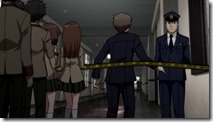 |
 |
 |
 |
 |
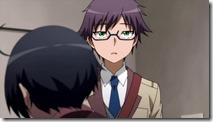 |
 |
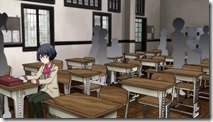 |
 |
 |
 |
 |
 |
 |
 |
 |
 |
 |
 |
 |
 |
 |
 |
 |
 |
ED: “Mikazuki (ミカヅキ)” by Sayuri
 |
 |
 |


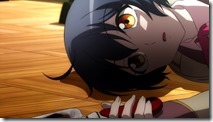

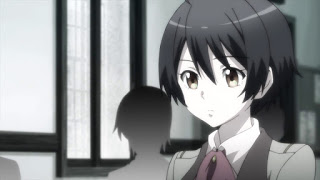
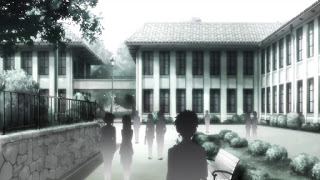
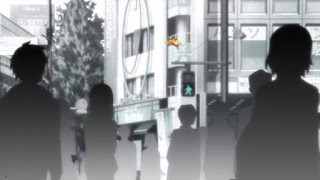
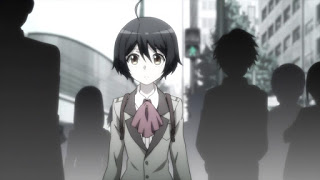
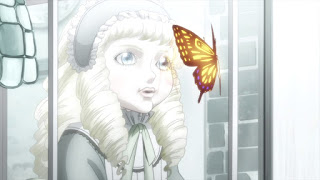
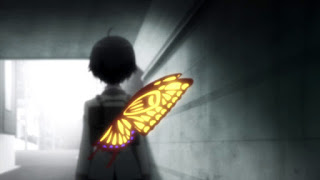



geekorner
July 3, 2015 at 7:33 amI hope it pays off! I'll keep an eye on what people say about this, I'm very curious about this show, but Seiji Kishi made me decide to not pick it up :-/
admin
July 3, 2015 at 7:38 amI hate to see Kishi's work dismissed out or hand, though he's sleepwalked through enough crap that I can understand it. When he's presented with dark, witty material (Jinrui, Aura, Kamisama Dolls) he does very well with it. That just doesn't happen often enough.
melodic thoughts
July 3, 2015 at 3:57 pmAs the episode pretty much hints at, the murder suspect definitely has some awareness of the homeroom teacher's homicidal fetishes (and may well be an accomplice/family), to have access and to have the time to plant the fingerprints on the murdered victims' items. Still, it is strange why a 13 year old is chosen to frame (maybe I shouldn't question that since this is anime setup).
I love the direction and angles employed here, and like you said, the use of blank figures in the background is pretty intelligent. It portrays Kobayashi's plain disinterest in the people around him (The superintendent was initially coloured, but immediately went into greyscale when he was shown in Kobayashi's view). I really like those kind of details in anime. And there was also new sensei's abnormal hypercuteness and her wrist cuts. These sort of untold narrative brings a lot of suspense and I'm looking forward to what comes next.
I wonder if it will be a case by case narrative structure like Un-Go. I usually prefer an overarching plot in anime, so I hope it is not too episodic.
roger p
July 3, 2015 at 5:43 pmthanks for the review, Enzo. This is one of the best executed and most capitivating first episodes I have seen; as soon as Kobayashi said something like 'that day my boredom came to an end' (which I think would have been perfect as a closing the prolude), it simply got me – can't wait to see how the story unfolds!
Kaname
July 4, 2015 at 12:23 amIt's a trap and I am convince that Kobayashi is actually a girl!
melodic thoughts
July 4, 2015 at 2:31 amAfter catching that blush face by class president when Kobayashi smiled at him, and I'm even more convinced it's a trap. Even the characters are delusionized by the cute looks
admin
July 4, 2015 at 5:44 pmIt's funny how any faintly yuri situation in anime is played up to the point where viewers see it even when it isn't there, but when a guy seems to show attraction to another guy it's immediately rationalized by saying the second guy is actually a girl. Is it so far-fetched that Kobayashi might actually be a girlishly-cute guy, and Hashiba might be into cute guys?
sonicsenryaku
July 6, 2015 at 2:02 ami dont know im sort of disappointed with this one. In short, it uses too many anime tropes; which would be okay if those tropes were used to good affect but here it doesnt seem like it does. The mystery, while having a sense of intrigue, doesnt really feel all too compelling so far but i guess that could change. i guess as of now, i find the mc to be one note and the direction actually doesnt do much for me. it's a shame since this was one of the anime i was looking forward to the most. Maybe it's just me but i feel like a story such as this should not be held down by such…cliches
tweetthebirdy
July 6, 2015 at 10:51 pmPretty excited to see where this goes! I'm a huge fan of NoitaminA and murder mysteries.
Also, in the future, would it be okay for you to not use the term "trap"? It's a pretty transphobic/homophobic term used in the anime community. It perpetrates the idea that men dress up as women to fool the heterosexual men, a "trap" if you will, which is something often accused of trans women (that they're not real women, they're just men pretending to be women, that they're disgusting and "fooling" heterosexual men). It's an idea that's often behind many trans hate crimes. The term "trap" also has basis in the idea that the only reason why a man might want to crossdress is to fool and seduce men for sex which obviously isn't the case – men can wear dresses simply because they like to!
Of course I understand you did not use the term intentionally to be transphobic nor are you a transphobic person, but the term itself remains transphobic so it would be great in the future if you could stop using it in reference to effeminate men. Thank you!
Stöt
July 8, 2015 at 12:26 pmI understand what you're saying but I feel that in anime "trap" characters are absolutely created to fool you (the audience and other characters), whereas an openly transperson in anime is just that.
Anyway, maybe I'm alone in that definition. I wouldn't call any non-fictional transperson a trap, and e.g. the main characters in Hourou Musuko I feel are not traps either.